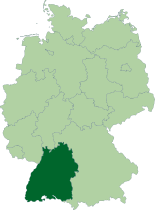Baden-Wuerttemberg
| Baden-Württemberg | |||
|---|---|---|---|
| State of Germany | |||
|
|||
 |
|||
| Coordinates: 48°32′16″N 9°2′28″E / 48.53778°N 9.04111°E | |||
| Country | Germany | ||
| Capital | Stuttgart | ||
| Government | |||
| • Minister-President | Winfried Kretschmann (Greens) | ||
| • Governing parties | Greens / CDU | ||
| • Bundesrat votes | 6 (of 69) | ||
| Area | |||
| • Total | 35,751.46 km2 (13,803.72 sq mi) | ||
| Population (2015-12-31) | |||
| • Total | 10,879,618 | ||
| • Density | 300/km2 (790/sq mi) | ||
| Time zone | CET (UTC+1) | ||
| • Summer (DST) | CEST (UTC+2) | ||
| ISO 3166 code | DE-BW | ||
| GDP/ Nominal | €461/ $507 billion (2015) | ||
| GDP per capita | €42,000/ $47,000 (2015) | ||
| NUTS Region | DE1 | ||
| Website | www.baden-wuerttemberg.de | ||
Baden-Württemberg (/ˈbɑːdən vɜːrtəmˌbɜːrɡ/;German pronunciation: [ˌbaːdn̩ˈvʏʁtm̩bɛʁk]) is a state in Germany located in the southwest, east of the Upper Rhine. It is Germany’s third largest state in terms of size and population, with an area of 35,751 square kilometres (13,804 sq mi) and 10.8 million inhabitants. The state capital and largest city is Stuttgart.
The sobriquet Ländle ("small land" or "dear land" in the local dialect) is sometimes used as a synonym for Baden-Württemberg.
Today's Baden-Württemberg is formed from the historical territories of Baden, Prussian Hohenzollern, and the Württemberg part of Swabia.
In 100 AD, The Roman Empire invaded and occupied Württemberg, constructing a limes (fortified boundary zone) along its northern borders. Over the course of the third century AD, the Alamanni forced the Romans to retreat beyond the Rhine and Danube rivers. In 496 AD the Alemanni themselves succumbed to a Frankish invasion led by Clovis I.
...
Wikipedia


